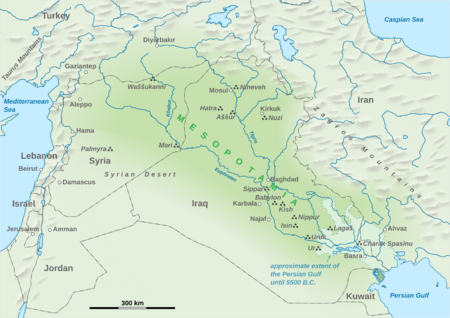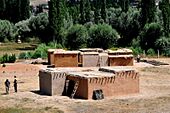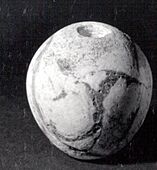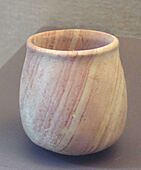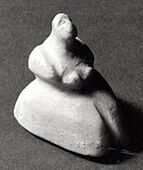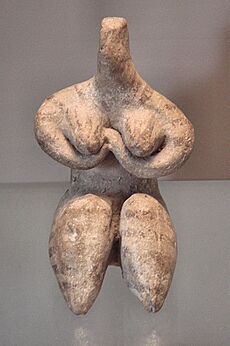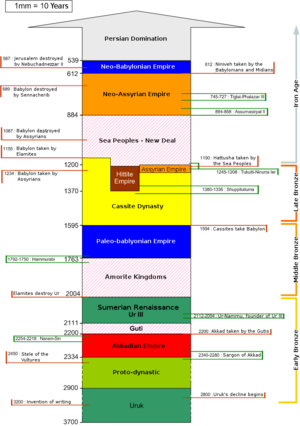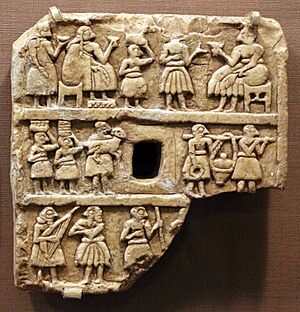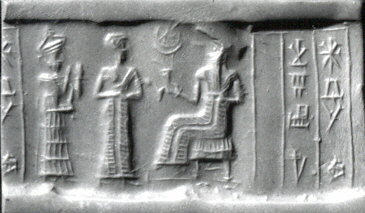History of Mesopotamia facts for kids
The history of Mesopotamia tells the story of this ancient land from the very first humans living there, all the way up to later times. We learn about this history from things found during archaeological digs and, after writing was invented around 4,000 BC, from many old documents.
At first, only parts of northern Mesopotamia were settled. But later, people moved into the southern areas. Mesopotamia was home to many of the world's oldest great civilizations. Because of this, it's often called a cradle of civilization, meaning it's where many important human developments began.
Contents
What is Mesopotamia?

The name Mesopotamia (pronounced Mess-oh-po-TAY-mee-uh) means "Between the Rivers." This name was first used around 400 BC to describe the land between the Euphrates and Tigris rivers. These rivers are mostly in modern-day Iraq.
Over time, the region of Mesopotamia grew to include not just Iraq, but also parts of modern-day Iran, Syria, and Turkey. Sometimes, the nearby dry plains to the west of the Euphrates and the western Zagros Mountains were also included.
Historians usually divide Mesopotamia into two parts:
- Upper or Northern Mesopotamia: This is the area between the Euphrates and Tigris rivers, from where they start down to the city of Baghdad.
- Lower or Southern Mesopotamia: This is the area from Baghdad down to the Persian Gulf.
The term Mesopotamia usually refers to the region's history until the Arab Muslim conquests in the 600s AD. After that, the region was known by different names like Syria, Jezirah, and Iraq.
How We Know the Dates
Historians and archaeologists use two main ways to figure out when things happened:
- Relative chronology: This tells us the order of events, like which period came before another. Archaeologists find this by digging carefully and seeing which layers of dirt are on top (newer) and which are below (older).
- Absolute chronology: This tells us the exact age in years. Methods like radiocarbon dating help date old objects. Also, ancient written records sometimes mention specific years or dates.
By combining these methods, experts have built a timeline for Mesopotamia. Even though there are still some debates, this timeline helps us understand the long history of this amazing region. Many periods are named after the places where important artifacts were first found, like the Halaf or Ubaid periods. When more written records became available, periods were often named after the most powerful ruling family or state, like the Ur III period.
Ancient Times
Early Farmers and Villages

In the early Neolithic period, people in Mesopotamia lived in the hilly areas near the Taurus and Zagros Mountains, and along the upper parts of the Tigris and Euphrates valleys.
Around 10,000 to 8,700 BC, people started to practice agriculture, meaning they began farming. The first signs of taming animals appeared around 9,000 BC. Important sites like Abu Hureyra show this change.
One incredible early site is Göbekli Tepe in southeastern Turkey. It has the oldest known large stone sculptures and circular buildings, dating back to this time. Experts believe these were built by many hunter-gatherers working together.
-
Inside the Shanidar Cave in northern Iraq. Here, remains of ancient humans called Neanderthals were found, dating back 65,000 to 35,000 years ago.
-
Skeletal remains of Shanidar II, from around 60,000 to 45,000 BCE. This is in the Iraq Museum.
-
A reconstruction of homes in Aşıklı Höyük, in modern Turkey.
-
Another Alabaster pot from the Mid-Euphrates region, 6500 BC, at the Louvre Museum.
Copper Age Cultures

After the last ice age, around 10,000 BC, several unique cultures thrived in the Fertile Crescent. One of the oldest known sites in Mesopotamia is Jarmo, settled around 7000 BC. It was similar in age to Jericho and Çatalhöyük. These early sites were in northern Mesopotamia.
Later, settlements in southern Mesopotamia needed clever irrigation systems to farm the land. The first of these was Eridu, settled by farmers from the Samarra culture in the north during the Ubaid period.
Halaf Culture (Northwest)
The Halaf culture (around 6100–5100 BC) is known for its beautiful pottery. This pottery was decorated with colorful, abstract patterns. People also made clay figures, often painted with lines, which might have been used in fertility rituals. Clay was a very important material. They traded their carefully made and dyed pots, especially jugs and bowls.
Hassuna Culture (North)
The Hassuna culture existed in northern Mesopotamia around the early 6th millennium BC. It is named after the site of Tell Hassuna in Iraq.
Samarra Culture (Central)
The Samarra culture was a Copper Age culture in central Mesopotamia, roughly from 5500–4800 BC. It existed at the same time as parts of the Hassuna and early Ubaid cultures.
Ubaid Culture (South)
The Ubaid period (around 6500–3800 BC) is a very early time in Mesopotamia's history. It's named after Tell al-'Ubaid in southern Mesopotamia, where important discoveries were made.
In the south, the Ubaid period was very long. It ended around 3800 BC, when the Uruk period began.
Ubaid Culture Spreads North
In northern Mesopotamia, the Ubaid period was shorter, from about 5300 to 4300 BC. It followed the Halaf period. Experts believe that the Halaf people adopted the Ubaid culture, rather than being replaced by invaders.
The Uruk Period: Rise of Cities
The Uruk period is named after the ancient Sumerian city of Uruk. This was a very important time because it saw the first true cities appear in Mesopotamia.
During the Uruk period (4th millennium BC), the Sumerian civilization really took shape. This period also saw the gradual invention of cuneiform script, one of the earliest forms of writing. This is why it's sometimes called the "Protoliterate period."
Third Millennium BC
Jemdet Nasr Period
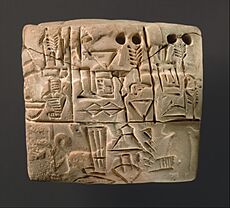
The Jemdet Nasr period (3100–2900 BC) is known for its unique painted pottery. The cuneiform script that started in the Uruk period became even better during this time. While we can't be totally sure, the language written on these tablets was likely Sumerian. These texts were mostly about managing things, like how much food was given out or lists of animals.
Cities in this period were very organized, often around a main building that controlled many parts of society. The economy relied on local farming and raising sheep and goats. The fact that the Jemdet Nasr culture was so similar across a large area of southern Mesopotamia suggests that cities traded and communicated a lot.
Early Dynastic Period: City-States Rule
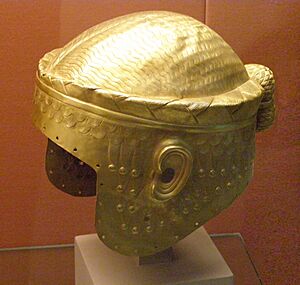
The Early Dynastic period (2900–2350 BC) was a time when the Sumerians were well established in Mesopotamia. We don't know exactly where the Sumerians came from because their language, Sumerian, is unique and not related to any other known language. Their myths talk a lot about Mesopotamia, suggesting they had been there for a very long time.
By the 3rd millennium BC, these city-states had grown into complex societies. They used advanced irrigation to produce lots of food. Rulers started huge building projects, and political systems became more advanced. Throughout this millennium, different city-states like Kish, Uruk, Ur, and Lagash fought for power. Nippur and Girsu were important religious centers. This was also the time of Gilgamesh, a legendary king of Uruk, who is the subject of the famous Epic of Gilgamesh. By 2600 BC, the early writing system had become the clearer cuneiform script.
It's hard to know the exact timeline for this period because our understanding of the texts and artifacts is still developing. Also, there were so many city-states, each with its own history. The Sumerian King List used to be seen as a key historical source, but now experts think it's not always accurate for political history.
Sometimes, one city-state would conquer others. For example, Enshakushanna of Uruk conquered much of Sumer. Later, Eannatum of Lagash also took control of Sumer, using force. But after his death, the cities rebelled, and his empire fell apart. Eventually, Lugal-Zage-Si was the last native Sumerian ruler to control most of Sumer before Sargon of Akkad took over.
The Akkadian language slowly replaced Sumerian as the main spoken language around 2000 BC. However, Sumerian continued to be used for religious, ceremonial, and scientific purposes in Mesopotamia for a very long time.
Akkadian Empire: The First Great Empire
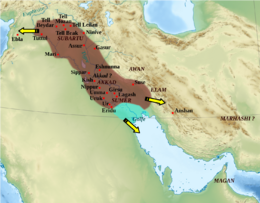
The Akkadian Empire (2350–2170 BC) was founded by Sargon around 2334 BC. He became ruler of Akkad in northern Mesopotamia and went on to conquer a huge area, from the Persian Gulf all the way into modern-day Syria. The Akkadians were a Semitic people. The Akkadian language became the common language, but Sumerian was still used for writing.
The Akkadians improved the Sumerian irrigation system. They built large weirs and dams to create reservoirs and canals, moving water over long distances. The empire reached its peak under Naram-Sin, who was the first ruler to claim he was a god.
The Akkadian Empire weakened after Naram-Sin's rule and was eventually invaded by the Guti people from the Zagros Mountains. The Guti controlled Mesopotamia for about 50 years, especially the south. After the Guti, the second dynasty of Lagash became important, with its most famous ruler being Gudea.
Ur III Period: Sumerian Revival
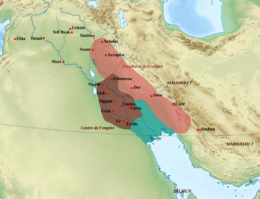
The Guti were eventually defeated by Utu-hengal of Uruk. Power then shifted to the city-state of Ur, when Ur-Nammu founded the Ur III Empire (2112–2004 BC). His son, Shulgi, brought state control over industries to a level never seen before. Shulgi might have created the Code of Ur-Nammu, one of the earliest known law codes, even older than the famous Code of Hammurabi.
Around 2000 BC, the power of Ur declined. The Amorites moved into much of the area. However, it was Sumer's old rivals from the east, the Elamites, who finally overthrew Ur. In the north, Assyria remained free from Amorite control for a while. This period marked the end of Sumerian dominance, but later rulers adopted many parts of Sumerian civilization.
Second Millennium BC
Early Assyrian Kingdom
Little is known about the very early history of Assyria. The Assyrian King List mentions kings from the 23rd and 22nd centuries BC. These early kings, who "lived in tents," were likely nomadic rulers. Over time, they settled down and founded the city-state of Ashur.
Around 1975 BC, Puzur-Ashur I started a new ruling family. His successors built temples to the gods Ashur, Adad, and Ishtar. Ilushuma (1945–1906 BC) was a powerful king who raided southern Mesopotamia and set up trading posts in Asia Minor. This rivalry between Assyria and Babylonia would continue for centuries.
Babylon Rises and Falls
The next two centuries (the Isin-Larsa period) saw southern Mesopotamia dominated by the Amorite cities of Isin and Larsa, who fought for control. In the north, Assyria grew stronger.
Babylon was founded as an independent state by an Amorite leader named Sumuabum in 1894 BC. For over a century, it was a small and weak state. But then, Hammurabi (1792–1750 BC), the Amorite ruler of Babylon, turned it into a major power. He conquered Mesopotamia and beyond. Hammurabi is famous for his law code and his conquests.
After Hammurabi's death, his empire quickly fell apart, and Babylon became a small state again. The Amorite rule in Babylon ended in 1595 BC when the Hittites conquered it. After that, the Kassites took control.
Unlike southern Mesopotamia, the native kings of Assyria kept the Amorites out during the 20th and 19th centuries BC. However, in 1813 BC, an Amorite king named Shamshi-Adad I took the throne of Assyria. He created a regional empire, expanding Assyrian influence. His son continued this, but later Assyrian kings became vassals of Hammurabi. Eventually, a native Assyrian leader overthrew the Amorites, and Assyria became strong again.
Middle Assyrian Empire
The Middle Assyrian period began around 1720 BC when the Amorites were driven out of Assyria. Assyria remained strong and stable. They made peace with the Kassite rulers of Babylonia and were safe from other threats.
However, the Mitanni kingdom dominated Assyria from the mid-15th to early 14th centuries BC. This ended when Ashur-uballit I (1365–1330 BC) completely defeated the Mitanni Empire. He founded a powerful Assyrian Empire that controlled Mesopotamia and much of the ancient Near East. Assyrian armies campaigned from the Mediterranean Sea to the Caspian Sea and from the Caucasus Mountains to Arabia. This empire lasted until 1076 BC. During this time, Assyria became a major power, even challenging Egypt.
Kassite Rulers of Babylon
The Kassites took over Babylon after the Hittites attacked it (around 1650–1155 BC). They ruled Babylon for over four centuries, making them the longest-lasting dynasty there. We don't have many records from this period, so it's a bit mysterious. The Kassites' language is also a mystery, as it's not related to any other known language.
Babylonia remained independent but was not a major power. It mostly stayed out of the big wars fought over the Levant between Egypt, the Hittite Empire, and Mitanni. However, the Kassites did fight their long-time rivals, the Elamites, to the east. Towards the end of their rule, Babylonia was often controlled by Assyria and Elam. Finally, the Elamites conquered Babylon, ending the Kassite period.
Hurrians and Hittites
The Hurrians were a people who settled in northwestern Mesopotamia and southeastern Anatolia around 1600 BC. By 1450 BC, they had built a medium-sized empire under a ruling class called the Mitanni. They became a threat to the Pharaoh in Egypt until Assyria defeated them. The Hurrian language is related to the later Urartian.
By 1300 BC, the Hurrians' power was broken by the Assyrians and Hittites. The Hittites were an Indo-European people who controlled most of Asia Minor (modern Turkey) from their capital, Hattusa. The Hittites fought with the Assyrians, losing some land. They lasted until the Phrygians conquered their homelands. The Assyrian king Tiglath-Pileser I stopped the Phrygians from moving further south into Mesopotamia. The Hittites then broke into smaller states, which lasted for many more centuries.
Bronze Age Collapse
Records from the 12th and 11th centuries BC are scarce in Babylonia. New Semitic groups, like the Arameans and Chaldeans, moved into the area. However, Assyria remained a strong nation with many written records. The 10th century BC is even more obscure for Babylonia.
Mesopotamia was not alone in this period of mystery. The Hittite Empire fell, and there are very few records from Egypt and Elam. This was a time of invasions and great change across the entire Near East, North Africa, and parts of Europe.
First Millennium BC
Neo-Assyrian Empire: The Biggest Empire Yet
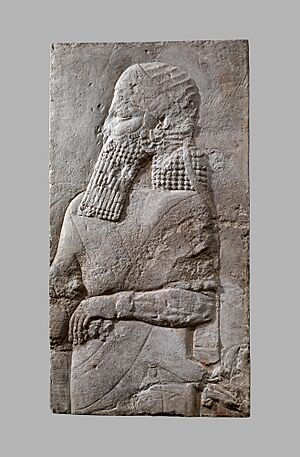
The Neo-Assyrian Empire is usually considered to have started with King Adad-nirari II in 911 BC. It lasted until the fall of Nineveh in 612 BC. This empire was the largest and most powerful the world had ever seen up to that point.
At its peak, Assyria conquered many lands, including Egypt, Babylonia, Elam, Media, Persia, Urartu, Phoenicia, Syria, Israel, and Judah. Assyrian armies campaigned from the Mediterranean Sea to the Caspian Sea and from the Caucasus Mountains to Arabia. They also defeated or received tribute from many other groups.
Neo-Babylonian Empire: Babylon's Last Glory
The Neo-Babylonian Empire began in 620 BC and ended in 539 BC. For the three centuries before this, Babylonia had been ruled by their northern neighbors, Assyria. The Assyrians had kept Babylonia loyal, sometimes by giving them special rights, and sometimes by force.
But after the last strong Assyrian ruler, Ashurbanipal, died in 627 BC, Babylonia rebelled under Nabopolassar, a Chaldean leader. Nabopolassar allied with King Cyaxares of the Medes, and with help from the Scythians and Cimmerians, they attacked and destroyed the Assyrian capital, Nineveh, in 612 BC. Assyria fell by 605 BC, and Babylon became the center of a great empire once again, for the first time since Hammurabi.
Later Empires and New Religions
After Ashurbanipal's death, the Assyrian empire fell into civil wars, allowing its former subjects to become free. The Medes and Babylonians then ruled Assyria. Both Babylon and Media later fell under Persian rule in the 6th century BC, led by Cyrus the Great.
For two centuries under Persian rule, both Assyria and Babylonia thrived. Achaemenid Assyria became a major source of soldiers and food for the empire. Mesopotamian Aramaic remained the common language.
Mesopotamia was conquered by Alexander the Great in 330 BC. It remained under Hellenistic (Greek) rule for another two centuries, with Seleucia as its capital. In the 1st century BC, Mesopotamia was often in conflict as the Greek Seleucid Empire weakened.
The Parthian Empire then ruled for five centuries, until the 3rd century AD, when the Sassanids took over. After many wars between the Romans and first the Parthians, then the Sassanids, the western part of Mesopotamia became part of the Roman Empire.
Christianity and Mandaeism (an ancient religion) came to Mesopotamia between the 1st and 3rd centuries AD. They grew strong, especially in Assyria, which became a center for the Assyrian Church of the East. This Christian tradition continues today. Some new Assyrian kingdoms also appeared, like Adiabene.
The Sassanid Empire and Byzantine Mesopotamia finally fell to the Rashidun army in the 630s. After the Arab-Islamic conquests in the mid-7th century AD, many Arabs and later Turkic people moved into Mesopotamia. The city of Assur was still inhabited until the 14th century, and Assyrians might have been the majority in northern Mesopotamia until the Middle Ages. Today, Assyrians still follow Eastern Rite Christianity, and Mandaeans keep their ancient religion and speak Mesopotamian Aramaic. People from these groups still often use traditional Mesopotamian names.
- Classical Antiquity
- Median and Babylonian Assyria (605 to 549 BC)
- Persian Babylonia
- Achaemenid Assyria (6th to 4th centuries BC)
- Seleucid Mesopotamia (4th to 2nd centuries BC)
- Parthian Asuristan (Assyria) (2nd century BC to 3rd century AD)
- Osroene (2nd century BC to 3rd century AD)
- Adiabene (1st to 2nd centuries AD)
- Roman Mesopotamia (2nd to 7th centuries AD), Roman Assyria (2nd century AD)
- Late Antiquity
See also
 In Spanish: Historia de Mesopotamia para niños
In Spanish: Historia de Mesopotamia para niños


